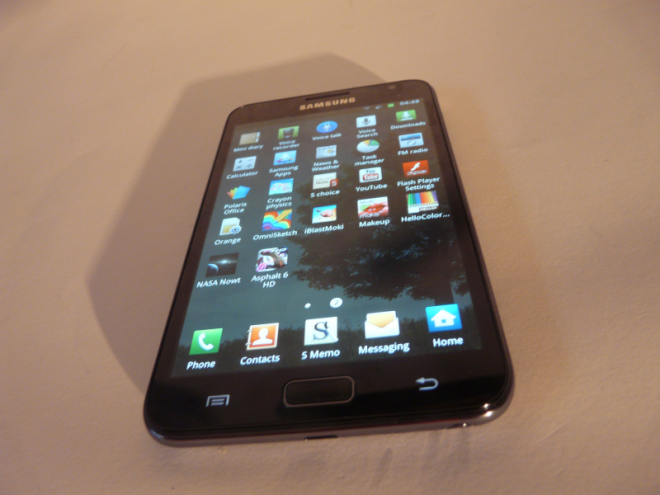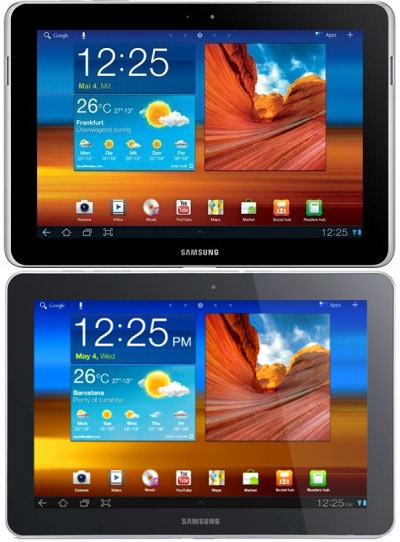First of all, I’d like to thank you for the 20+ likes of the video review of the Samsung Galaxy Note and funny comments about my accent. They were hilarious! Next up, I have here the text review for you, revealing what this interesting 5.3 inch device can do. Remember that this is not a smartphone, not a tablet, but a Note, as a Samsung official said.
The first feeling you have when using the Samsung Galaxy Note is that you’ve stumbled upon a larger than life Samsung Galaxy S II. It actually has the same design, the same interface, the same form factor with a larger diagonal and even the same camera with the same potential. What’s different is the screen resolution and size, plus the power of the CPU and the stylus input. But a comparison with a smartphone doesn’t have its place here, since this is closer to a tablet than a handset… After all, it’s larger than the TABLET Dell Streak.
First things first: this gadget measures 9.7mm in thickness, which is actually OK considering the size of the screen and it weighs 178 grams, that’s a bit of a pocket breakers. The specs include LTE connectivity, in the networks where this is available, plus a Super AMOLED 5.3 inch screen with a 800 x 1280 pixel resolution and a dual core 1.4GHz Exynos CPU, plus a Mali 400 MP GPU. The display is protected by the Gorilla Glass technology, unlike some other new Samsung piece of gear, the Galaxy Nexus.
Also on board of the Note we find 16/32GB of on internal memory, a gyroscope, 1GB of RAM, a microSD card slot, support for HSDPA 21Mbps connectivity, WFi 802.11 a/b/g/n, DLNA and Bluetooth 3.0. As far as the camera goes, we get a front sensor for videocalls, with 2MP resolution, plus the main shooter at the back, an 8 megapixel camera with autofocus, LED flash, geotagging, touch focus, face detection, image stabilization and 1080p 30 fps video capture. I have to say that the photos taken during daylight, including a cloudy day are stunning and you saw in the video review how much I zoomed into a photo I’ve just taken… It’s fantastic! However, in a room that’s not so brightly lit things will be different and both photos and video will suffer.
Going on to the software side, Android 2.3 Gingerbread is here, all covered in Touchwiz 4.0 and also relying on the Samsung Apps store. In comparison to the Samsung Galaxy S II review, now we have a lot more apps in the store, so things have improved. TouchWiz brings the usual unique and large widgets, plus the Hubs: Readers Hub, Social Hub and Music Hub. The latter is sort of a music store from Samsung, while the first gather Kobo and Zinio subscriptions in one and throws in a magazine reading section and also one for newspapers. What’s nice is that once you download a newspaper it can be ready to you out loud, so the people with eye problems will enjoy their daily paper. The book reading section is also nice and powered by Kobo.
Since this is a business device after all, I must mention the S-Pen stylus, integrated at the back of the Note. This accessory has a button of its own, that when pressed and keeping it pressed on the screen makes a screenshot of the current image. IF you keep the button pressed and double tap the screen, you’ll trigger a lite version of the note taking app. As far as writing in the Memo and Mini Diary apps goes, this is a fairly easy task, providing your writing is legible, unlike mine. There’s also the option to use the stylus anywhere there’s input, like in the web browser or the messaging area. There’s a box at the bottom of the screen where stylus input becomes text in your text or address bar, so it’s all cool.
And then there’s the S Planner, that force closed on me a couple of times. This is a very good calendar for people with busy scheduled and you saw that mine was loaded with Facebook birthdays and Google account appointments. However, browsing through it and planning ahead months, weeks and days is a breeze. Samsung Galaxy Note also comes with GPS, Stereo FM Radio, NFC, a digital compass and barometer, plus a Li-Ion 2500 mAh battery, that should provide you around a day of fun. You’ll get about 12 hours of juice from it, if you’re really into web browsing, gaming and movie watching.
The multimedia experience on the device is fantastic, both in video and audio playback, plus there’s also editing available for photos and videos. Both get a pretty decent set of options and the Movie editor actually felt like the WIndows Movie Maker, since it allows you to do the exact same things and it supports photo files, vidoes, audio files, transitions and effects, so it’s very cool. Swype input is present as usual for Samsung, but who needs that when you’ve got handwriting and the nifty stylus?
HD Games look great on the huge display, as shown at the end of the review, when I gave you a taste of Asphalt 6. I seem to have forgotten about the Social Hub, that gathers your texts, Facebook statuses of your friends and tweets and puts them in the same area of the menus. Everything looks fairly nice in this app and it updates pretty fast, I’ll give you that. Especially in landscape things become more clear and you can select if you want only Facebook or Twitter in the socializing area.
There’s a doodling app called OmniSketch that I recommend you use, especially if you’re good at drawing. I had a blast with it and I’m not event talented. Another thing you must know is that this device supports .mkv 1080p video playback and it does this without hiccups. Actually, lag is not present on this handset in any way, but maybe I didn’t open enough apps at the same time or learned to close them using the needed widget for that.
The thing here is that the average Samsung Galaxy S II user won’t feel the need to switch to this device, especially if he also owns a tablet. However, his friend, who doesn’t own a Galaxy S II or tablet, might use the Note to replace both items in one shot, especially because the Note is also a phone, it places calls, has a phone option that’s very handy and sends texts, too. The problem here is that you might look ridiculous holding this ping pong palette to your ear and it doesn’t even fit your face at times. In the end the choice is yours, but in this case size matters greatly and we’re going for minimalism not this huge gadget… What do you think?












